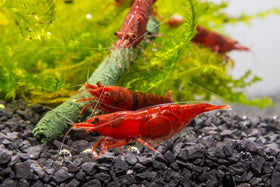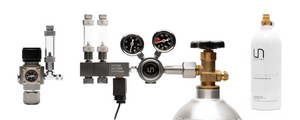
6 Tips for a Healthy Fish Tank
Written by: Tammy (@aquarist_tl) and Team Buce Plant
Keeping freshwater fish, shrimp, and snails is different from raising other types of pets. Essentially, we have to maintain an entire ecosystem for them. Their fish tank is the world they live in, and it’s our responsibility to make sure everything is running smoothly in it. We have to keep many factors in mind, such as water parameters and waste levels. It's important to consider not just the current health of your fish, but the entire aquarium.
Here are some aquarium tips I’d like to share that have helped me keep my aquariums in proper conditions:
1. Observe the Inhabitants

An aquascape featuring Rice Fish
One of the simplest (and most personally therapeutic) things you can do is to just watch your aquarium. Consistently be on the lookout for anything that looks strange, such as erratic movement of the fish or shrimp, heavy breathing/gasping, lethargy, or other signs of sickness. When you’re feeding, make sure you see that every fish is going for the food. If a fish stops eating out of the blue one day, unfortunately, this is a big indication that it could be sick.
The quicker you can spot that something is wrong, the better it will be in the long run because you can treat the problem faster; especially if it’s an illness. It’s much more difficult to treat a fish that's been infected for a long time because it will be much weaker than if you had caught it early on. Your fish may not have the energy to recover if the disease has progressed too far.
2. Perform Daily Checks on Equipment
Another thing to look out for when viewing your fish tank is the equipment. Make sure everything in the aquarium is running properly since one broken cog can cause the ecosystem to crash. Arguably, the most important pieces of equipment to inspect for your tank's inhabitants' health are the heater and the tank filter.
In regards to the heater, I like to have a thermometer in the tank. This allows me to always be able to check the temperature of the water and ensure that the heater is working fine. If you don’t need a heater for your aquarium, then you have one less thing to worry about!
When it comes to the aquarium filtration system, you need to make sure that water is flowing properly. If you have a hang-on-back filter or a canister filter, this is easy to check. As long as the outflow has water flowing out at the correct flow rate, it’s working. If it’s slower than usual or barely has water coming out, then it’s probably clogged and it's time to clean the filter. If there’s no water coming out at all, it may be broken and would have to either be fixed or replaced.
For sponge filters, it may be harder to inspect them because you can’t always see if the water is flowing through them or not. First, check to see that the air pump is working by looking at the number of bubbles coming out of the filter. If everything looks normal, then inspect the sponge. If it’s looking dirty and clogged up, then you should wring it out in a bucket of aquarium water to get it clean again.
- Extra Tip: If possible, it’s always good to keep backup equipment in case something breaks. This way, you can immediately address the issue once you notice it.
3. Have Good Feeding Practices
Feeding the proper foods in the right amounts is a fundamental aspect of fishkeeping that affects the health of both the aquarium and its inhabitants. Overfeeding can ultimately kill your fish. Not only can it result in health complications from eating too much, but fallen or uneaten food can result in a dirty tank.
The leftover fish food will quickly rot and can result in an ammonia spike, making the water toxic and possibly even life-threatening for the fish and shrimp living in it. On the other hand, feeding too little can cause the weaker or slower fish to slowly starve over time. Try to feed just enough where you can see that everyone is able to get a few bites in. If you notice that an abundant amount has sunk to the bottom of the tank, make sure to use a gravel vacuum to siphon it out to prevent it from decaying.

LEGIT Fish Food is made with a blend of quality ingredients
Feeding the right food for the inhabitants being kept is key to helping them stay healthy. Some fish need more veggies, some need more meat, and some need a balance of both. Look into the ideal diet for the species that you have to make sure they’re eating the right foods.
On top of the diet, the types of food itself can also help particular species of fish. Bottom feeders like plecos and corydoras may not be getting enough to eat if the food is always floating at the surface of the water. Sinking foods like wafers or pellets would help ensure they’re eating well.
4. Quarantine

One of the best practices you can adopt to keep your aquarium healthy is to quarantine any new livestock and quarantine all live plants (except tissue culture) before putting them into your tank. By doing this, you are protecting the aquarium from any harmful diseases or unwanted organisms that may enter it through the new additions. New fish may have diseases that could spread and infect your current fish. New plants could bring in pesticides, harmful pests, or algae.
- To learn more about quarantining, feel free to check out these articles: How to Quarantine Aquarium Fish and How to Quarantine New Aquarium Plants
5. Test Your Water (Often!)

Your tank's water quality is arguably the most important factor in keeping your fish healthy. The beneficial bacteria in your tank will keep the aquarium safe and comfortable for the livestock. Because of this, it’s a good habit to periodically test your aquarium water. This way, you always have an idea of your parameters and you’re able to identify if anything is wrong before it affects the tank’s inhabitants.
It also helps to know the level of the nitrates, ammonia, and nitrites so that you know how much water to change/how frequently you need to change to keep the aquarium's nitrogen cycle in order.
Learn more about the importance of water changes in this article: How to Perform a Water Change (& Why it's Important!)
6. Keep a Schedule for Routine Maintenance
It helps to have a set day when you perform maintenance on your tank. When you do, you’re more likely to fall into a rhythm of routinely cleaning the aquarium and are less likely to skip or put it off for too long. Maintenance is important for the health and balance of the aquarium, so it’s crucial for us to stay on top of it. Try to choose the same time and day of the week to perform regular water changes and routine equipment checks, and just watch your aquarium's activity at least once a week.
For more fish tank cleaning tips, check out our article: How to Do Planted Tank Maintenance Without Going Crazy
Hope this information helps out anyone in the aquarium hobby, whether you are new or experienced! Happy fishkeeping!
Tell us - Was this article helpful? Please leave a comment below!
If you have any questions regarding this article, please DM us on Instagram, Facebook, or email support@buceplant.com so we can assist you - @buceplant






Comments
Leave a comment